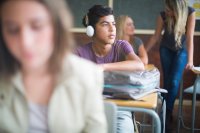3 Ways to Use Music in the Classroom
A high school teacher shares how she uses music to foster a sense of community and make learning more engaging.
How many times have you had to ask a student to remove their headphones this week? It’s a request that I make daily in my classroom, and though I’ve learned to be less frustrated by students isolating themselves with a wall of sound, I never really understood why that’s so pervasive.
The other day I stopped to really consider this problem. Why are so many of our young people walking around with their ears stopped up, blocking out much of the world around them and missing valuable moments in the classroom by not being fully present? I decided to ask them, and the vast majority of the answers I received were variations on the same theme: “Music makes me happy.”
I’m not sure why it took me so long to think of tapping into the power of music in my classroom—music is obviously not new. In fact, a 2001 book called The Biological Foundations of Music claimed that it goes back more than 250,000 years, though the oldest excavated instruments are around 40,000 years old. While the origins and purposes of music still fascinate and mystify researchers, teachers know for sure that it is engaging to students.
Here are some ways I’ve found to use music in my classroom to spark joy, create community, and make learning more engaging.
3 Ways to Tap Into the Power of Music
1. Create playlists for different occasions in class: I discovered this idea on Twitter recently and decided to have my students create a playlist of songs they’d like to play to wake up after quiet activities or when they’re feeling a little sleepy.
I didn’t realize the full impact of implementing this idea until I had a full class of 11th graders singing the chorus to “Sweet Caroline” by Neil Diamond. What I had intended as a way to infuse my classroom with a little more fun turned into a moment of joy and community building.
Now, I’m building, with the help of student suggestions, playlists of songs to listen to while students are writing, doing choice reading, and entering and exiting the room. I can enhance the mood of my students with just a click of the mouse.
2. Use music to help students remember important facts: I noticed the Spanish teachers at our high school using music to help students learn and remember the alphabet and the days of the week, and those of us of a certain age learned the preamble to the Constitution and many grammatical rules from watching Schoolhouse Rock! on Saturday mornings. Why not have students make up songs to remember other facts and ideas they need to internalize?
I decided to experiment. Instead of our traditional vocabulary activities, I divided up a list of literary devices and gave groups of students a few words each to create a song for. Using karaoke tracks of popular tunes as backing tracks, students had a surprising amount of fun making up songs to help them remember the function and effect of each of the terms. The performances were epic: Imagine students singing, “Is this the real life; is this hyperbole? Exaggerating for the effect that you want me to see!” to the tune of Queen’s “Bohemian Rhapsody” and “Don’t stop litotes! Use double negatives and you won’t be sorry!” to Journey’s “Don’t Stop Believing.”
3. Use students’ music preferences to connect to your subject matter: In my English classroom, I use music lyrics to introduce poetry analysis. When students first enter my class, they are often apprehensive about their ability to understand and talk about poetry, and music lyrics are a familiar and compact medium for discussing many of the aspects of analysis.
We start with a short, simple song such as Pink Floyd’s “Wish You Were Here,” and after digging into the multiple layers of meaning in the lyrics, I assign students a “Music as Poetry” project. They select a song—one that’s appropriate to share in class. Then they print out the lyrics and annotate them for tone shifts, patterns, structure, and any other literary devices they can find. Next they write up a theme statement for the song, and an explanation of how the literary devices they found in the song contribute to that theme.
Students present their songs to the class along with their analyses. The students get practice noticing literary devices that pop up in the real world, and I get exposed to some wonderful songs I’ve never heard before. Students have introduced me to artists such as Kasey Musgraves, Billie Eilish, and Kendrick Lamar, and along the way, I’ve come to know my students a little better through their musical tastes—a win-win in my book.
I don’t have songs playing constantly in my classroom—there are times when silence is more effective, such as with certain writing and reading tasks, and every teacher needs to determine this balance for themselves. But it cannot be denied that music exerts a powerful pull on our students, a pull that can be harnessed to create a more effective learning environment.
